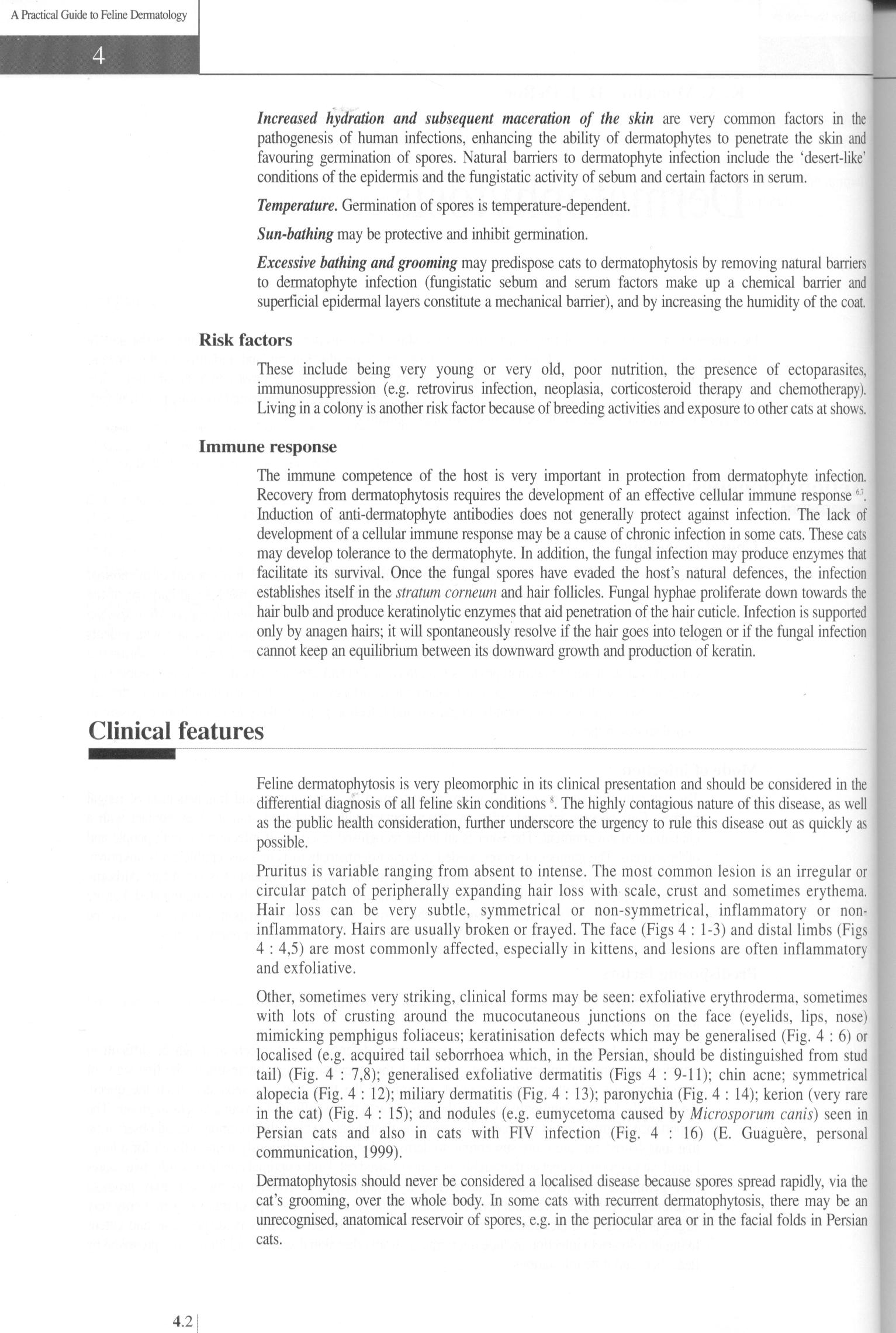42 (226)

4
A Practical Guide to Feline Dermatology
Increased hydration and subsequent maceration of the skin are very common factors in the pathogenesis of human infections, enhancing the ability of dermatophytes to penetrate the skin and favouring germination of spores. Natural barriers to dermatophyte infection include the ‘desert-like’ conditions of the epidermis and the fungistatic activity of sebum and certain factors in serum.
Temperaturę. Germination of spores is temperature-dependent.
Sun-bathing may be protective and inhibit germination.
Excessive bathing and grooming may predispose cats to dermatophytosis by removing natural barriers to dermatophyte infection (fungistatic sebum and serum factors make up a Chemical barrier and superficial epidermal layers constitute a mechanical barrier), and by increasing the humidity of the coat.
Risk factors
These include being very young or very old, poor nutrition, the presence of ectoparasites, immunosuppression (e.g. retrovirus infection, neoplasia, corticosteroid therapy and chemotherapy). Living in a colony is another risk factor because of breeding activities and exposure to other cats at shows.
Immune response
The immune competence of the host is very important in protection from dermatophyte infection. Recovery from dermatophytosis reąuires the development of an effective cellular immune response67. Induction of anti-dermatophyte antibodies does not generally protect against infection. The lack of development of a cellular immune response may be a cause of chronic infection in some cats. These cats may develop tolerance to the dermatophyte. In addition, the fungal infection may produce enzymes that facilitate its survival. Once the fungal spores have evaded the host’s natural defences, the infection establishes itself in the stratum corneum and hair follicles. Fungal hyphae proliferate down towards the hair bulb and produce keratinolytic enzymes that aid penetration of the hair cuticle. Infection is supported only by anagen hairs; it will spontaneously resolve if the hair goes into telogen or if the fungal infection cannot keep an eąuilibrium between its downward growth and production of keratin.
Clinical features
Feline dermatophytosis is very pleomorphic in its clinical presentation and should be considered in the differential diagnosis of all feline skin conditionsK. The highly contagious naturę of this disease, as well as the public health consideration, further underscore the urgency to rule this disease out as ąuickly as possible.
Pruritus is variable ranging from absent to intense. The most common lesion is an irregular or I circular patch of peripherally expanding hair loss with scalę, crust and sometimes erythema. Hair loss can be very subtle, symmetrical or non-symmetrical, inflammatory or non- I inflammatory. Hairs are usually broken or frayed. The face (Figs 4 : 1-3) and distal limbs (Figs I 4 : 4,5) are most commonly affected, especially in kittens, and lesions are often inflammatory I and exfoliative.
Other, sometimes very striking, clinical forms may be seen: exfoliative erythroderma, sometimes I with lots of crusting around the mucocutaneous junctions on the face (eyelids, lips, nose) mimicking pemphigus foliaceus; keratinisation defects which may be generalised (Fig. 4 : 6) or I localised (e.g. acquired taił seborrhoea which, in the Persian, should be distinguished from stud I taił) (Fig. 4 : 7,8); generalised exfoliative dermatitis (Figs 4 : 9-11); chin acne; symmetrical alopecia (Fig. 4 : 12); miliary dermatitis (Fig. 4 : 13); paronychia (Fig. 4 : 14); kerion (very rare in the cat) (Fig. 4 : 15); and nodules (e.g. eumycetoma caused by Microsporum canis) seen in I Persian cats and also in cats with FIV infection (Fig. 4 : 16) (E. Guaguere, personal I communication, 1999).
Dermatophytosis should never be considered a localised disease because spores spread rapidly, via the cat’s grooming, over the whole body. In some cats with recurrent dermatophytosis, there may be an unrecognised, anatomical reservoir of spores, e.g. in the periocular area or in the facial folds in Persian I cats.
4.2
Wyszukiwarka
Podobne podstrony:
58 (148) 5 A Practical Guide to Feline Dermatology severity of the illness. High titres are seen wit
65 (127) 6 A Practical Guide to Feline Dermatology Other topical antimicrobial agents, such as chlor
67 (125) 6 A Practical Guide to Feline DermatologyNocardiosisAetiopathogenesis Nocardiosis is a very
69 (119) 6 A Practical Guide to Feline DermatologyDiagnosis The diagnosis is based on lesion distrib
710 (2) 7 A Practical Guide to Feline DermatologyHerpesvirus infections Dermatological manifestation
74 (105) 7 A Practical Guide to Feline Dermatology ulcerated. Lesion distribution is multicentric bu
27 A Practical Guide to Feline Dermatology Perianal glands 1.7 Permethrin 3.12, 3.13 Persian 1.6,2.2
27 A Practical Guide to Feline Dermatology Stemphyllium spp. 5.1,7.8 Stereotypie behaviour 17.1,
272 (16) 27 A Practical Guide to Feline Dermatology Alternaria spp. 5.1,7.8 Aluminium hyroxide 15.6&
274 (18) 27 A Practical Guide to Feline Dermatology Colitis 11.2 Collagen 1.2,2.6,12.1,
278 (17) 27 A Practical Guide to Feline Dermatology I J Histoplasmosis 5.8, 7.8, 25.2 Homer’s syndro
28 (374) 2 A Practical Guide to Feline Dermatology Configuration of lesions Determining the configur
313 (14) A Practical Guide to Feline Dermatology The second phase consists of long-term control of t
31 (328) 3 A Practical Guide to Feline Dermatology Sarcoptic mange Sarcoptes scabiei var canis (Tabl
82 (128) 8 A Practical Guide to Feline Dermatology considered important parasites. Cats in the Unite
44 (228) 4 A Practical Guide to Feline Dermatolog) The term “asymptomatically infected cat” refers
46 (213) 4 A Practical Guide to Feline Dermatology from cats with untreated infections are often pos
48 (209) 4 A Practical Guide to Feline Dermatology Table 4:1: Type of hair invasion, fruiting bodies
510 (5) A Practical Guide to Feline DermatologyCoccidioidomycosisAetiopathogenesis Coccidioidomycosi
więcej podobnych podstron